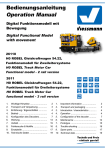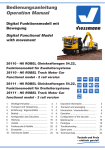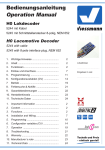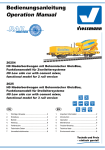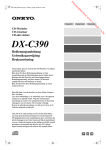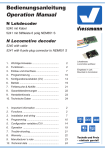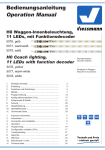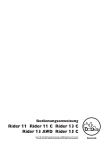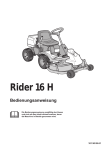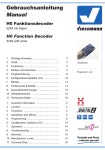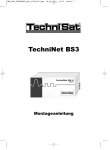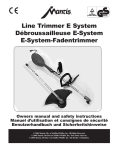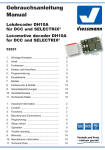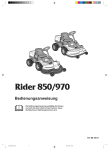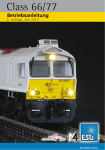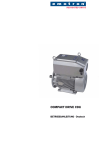Download Bedienungsanleitung Operation Manual
Transcript
Bedienungsanleitung Operation Manual Schienen-Stopfexpress Plasser & Theurer 09-3X Tamping machine Plasser & Theurer Stopfexpress 09-3X 26052, 26054, 26091, 26093, 26095, 26096, 26098, 26099 1. Wichtige Hinweise...................................... 2 2. Transport und Verpackung......................... 3 3. Einführung / Eigenschaften........................ 5 4. Betrieb........................................................ 5 5. Konfiguration des Decoders ..................... 11 6. Wartung..................................................... 16 7. Vorbild........................................................ 19 8. Fehlersuche & Abhilfe ................................ 20 9.Ersatzteile ................................................... 21 10. Technische Daten...................................... 24 1. Important Information.................................2 2. Transport and packaging............................ 3 3. Introduction / characteristics......................5 4. Operation....................................................5 5. Configuration of the decoder......................11 6. Maintenance...............................................16 7. Prototype....................................................19 8. Troubleshooting.........................................20 9. Spare parts .................................................21 10. Technical Data............................................24 DCC MM Rail Com ◄► DC = AC ~ NEM DE 1. Wichtige Hinweise Vor Gebrauch die Sicherheitshinweise und Anleitung genau lesen und beachten! Anleitung aufbewahren. Sie ist Teil des Produktes. Sicherer Betrieb EN 1. Important Information Read and follow these safety precautions and instructions carefully before use! Keep this manual. It is part of the product. Safe operation Vorsicht: Verletzungsgefahr! Aufgrund der detaillierten Abbildung des Originals bzw. der vorgesehenen Verwendung kann das Produkt Spitzen, Kanten und abbruchgefährdete Teile aufweisen. Das Produkt gehört aus diesem Grund nicht in die Hände von Kindern! Attention: Risk of injury! Due to the detailed reproduction of the prototype respectively the intended application this product may have sharp edges and parts prone to breaking. Therefore this product is not intended for children! Take care: Risk of electrocution! Please check the supply unit (transformer, power supply unit) regularly for damaged cables, plugs etc. or damage to the housing. Should there be any damage do not use this power supply anymore! Vorsicht: Stromschlaggefahr! Verwendetes Versorgungsgerät (Transformator, Netzteil) regelmäßig auf Schäden an Kabeln, Stecker, Gehäuse usw. prüfen. Bei Schäden am Versorgungsgerät dieses keinesfalls benutzen! Attention: The model contains electronic respectively mechanical subassemblies. It may only be opened at the pre designated places. It may not be damaged or exposed to humidity. The subassemblies mentioned above are essential for trouble free operation. Achtung: Das Modell enthält eine elektronische bzw. mechanische Baugruppe. Es darf nur an den dafür vorgesehenen Stellen geöffnet werden. Es darf nicht beschädigt oder mit Feuchtigkeit in Verbindung gebracht werden. Die genannten Baugruppen sind für den einwandfreien Betrieb erforderlich. Attention: Risk of breakage! Always handle this model carefully since the many fine detailed parts may otherwise be damaged. Achtung: Bruchgefahr! Modell stets vorsichtig am Gehäuse anfassen, da die filigranen Teile des Modells sonst abbrechen könnten. Abb. 1 Achtung: Betreiben Sie den Stopfexpress niemals unbeaufsichtigt und verwenden Sie ihn niemals zur Beförderung von Personen oder Tieren. Das Produkt richtig verwenden Das Produkt darf ausschließlich dieser Anleitung gemäß verwendet werden. Dieses Schienenfahrzeugmodell ist bestimmt • zum Betrieb auf Modelleisenbahnanlagen der Baugröße H0, • zum Betrieb mit einem zugelassenen Modellbahntransformator mit einer Ausgangsspannung von max. 21 V bzw. an einer Digitalzentrale der Formate DCC und / oder Märklin Motorola (MM) wie bspw. dem Viessmann Commander 5300, • 2 zum Betrieb in trockenen Räumen. Jeder darüber hinausgehende Gebrauch gilt als nicht bestimmungsgemäß. Für daraus resultierende Schäden haftet der Hersteller nicht. Dies ist ein Sammlermodell! Nicht geeignet für Kinder un- Attention: Never leave the track maintenance train (tamping express) unattended during operation and never use it for transporting persons or animals. Using this product in the right way This product may only be used as described in this manual. This rail-bound vehicle is intended for operation as follows • For operation on a H0 model train layout, • For operation with an approved transformer for model trains with a secondary voltage of max 21 V respectively a digital command station supplying DCC and / or Märklin Motorola (MM) such as the Viessmann Commander 5300, • For operation in dry rooms. Any other use of this product is not permitted. The manufacturer is not liable for any damage due to inappropriate use. This is a collector´s item! Not suitable for children less than 14 years old. Inappropriate use may result in injury. ter 14 Jahren. Bei unsachgemäßem Gebrauch besteht Verletzungsgefahr. 2. Transport und Verpackung Der Stopfexpress ist ein fein detailliertes und empfindliches Modell. Damit Sie lange Freude an diesem Zug haben, ist er gut verpackt und verschiedene Zurüstteile sind im Auslieferungszustand nicht montiert. Wir empfehlen, den Stopfexpress bei Nichtgebrauch in der Originalverpackung zu lagern. 2. Transport and packaging The tamping express is a finely detailed and delicate model. To make sure that you can enjoy this train for a long time it is well packaged with many detail parts to be mounted by yourself. We recommend storing the tamping express in the original packing when not in use. Purchased parts package Please check that all parts have been supplied in the package: Lieferumfang ► Model of the tamping express, Kontrollieren Sie nach dem Auspacken den Lieferumfang auf Vollständigkeit: ► This manual ►Modell Stopfexpress, ►Beutel mit Zurüst- und Ersatzteilen ►diese Anleitung. ► Pouch with detail parts and spare parts Remove the vehicle from the transport packing Fahrzeug aus der Transportverpackung entnehmen Achtung: Bruchgefahr! Modell stets vorsichtig mit beiden Händen am Gehäuse anfassen, da die filigranen Teile des Modells sonst abbrechen könnten. Niemals an Aggregatrahmen, Dach oder Drehgestellen festhalten. Bitte alle Verpackungsteile und diese Anleitung für späteren Gebrauch aufbewahren. Nur die Originalverpackung garantiert Schutz vor Transportschäden. Zur besseren Entnahme des Zuges aus dem Styroporträger ist dieser auf zwei Folienstreifen gebettet. Attention: risk of breakage! Always hold the model with both hands on the housing, since some of the fine detail parts may break. Never hold it by the aggregate frame, the roof or the bogies. Please keep all parts of the packaging and this manual for later use. Only the original packaging protects the model from transport damage. The train is placed on two foils for easier removal from the Styrofoam base. ►Take Styrofoam base sideways out of the carton. ►Grab the foils (both ends) with one hand each and pull the train uniformly from the Styrofoam Abb. 1 Fig. 1 hinten rear Antriebsdrehgestell bogie with drive unit Dachteil abnehmbar removable roof section Schlitten mit Stopfeinheit tamping unit vorn front Aggregatrahmen aggregate frame Arbeitsrichtung direction of working 3 ►Styroporträger seitlich aus dem Karton nehmen. ►Die Folienstreifen (beide Enden) mit jeweils einer Hand greifen und den Zug gleichmäßig aus dem Styroporträger ziehen. Gegebenenfalls Styroporträger fixieren. ►Zug aufrecht auf einen Tisch oder auf die Gleise stellen. Folienstreifen beiseite legen. ►Alle Teile der Verpackung für späteren Gebrauch aufheben Fahrzeug in Transportverpackung verpacken Achtung: Zerstörungsrisiko! Die Stopfeinheit am Aggregatrahmen muss sich in einer speziellen Parkposition befinden, damit der Zug korrekt in den Styroporeinleger der Verpackung passt! Die Stopfeinheit und den Schlitten auf dem Aggregatrahmen niemals von Hand verschieben! Eine Zerstörung der Feinmechanik wäre die Folge. ►Den Zug aufgegleist in den Arbeitsmodus bringen. Der Aggregatrahmen muss in vorderster Position sein (Aggregatrahmen steht in Endposition zur Zugspitze). Zur Aktivierung des Arbeitsmodus die entsprechenden Kapitel weiter unten beachten! Nach Positionierung des Aggregatrahmens in vorderster Stellung Zug stromlos schalten und vom Gleis nehmen. ►Folienstreifen im Abstand der Hauptdrehge- base. If necessary fasten the Styrofoam base. ►Place the train upright on a table or on the track. Put the foils aside. ►Keep all parts of the packaging for later use. Insert the vehicle in the transport packaging Attention: risk of damage or destruction! In order to be able to insert the train into the Styrofoam base of the packaging the tamping unit on the aggregate frame must be in a specific parking position! Never move the tamping unit or the sliding carriage on the aggregate frame by hand! This could lead to the destruction of the precision mechanics. ►Bring the train into working mode while it is on the track. The aggregate frame must be in the forward position (as far as possible – the aggregate frame is located at the end position facing the head of the train). ►For activating the working mode please refer to the chapter further on in this manual! Once the aggregate frame is located in the forward position turn off the power and remove the train from the track. ►Place the foils at the same spacing as the main bogies parallel on a soft base (e.g.: foam support). Abb. 2 Fig. 2 Arbeitsrichtung direction of working Verpacken: Der Aggregatrahmen muss in vorderster Position sein (Aggregatrahmen steht in Endposition zur Zugspitze). Packing into the box: 4 The machine unit has to be placed in front position (machine unit position next to front of the train). vorn front stelle parallel auf einen weichen Untergrund legen (z. B. Schaumstoffunterlage). ►Zug so seitlich auf die Folienstreifen legen, dass die vordere Kabine (Zugspitze) links ist. ►Die Folienstreifen (beide Enden) mit jeweils einer Hand greifen und den Zug gleichmäßig mit der vorderen Kabine nach links in den Styroporträger legen. Fahrzeug anheben / tragen Fassen Sie den Stopfexpress stets am Gehäuse an. Benutzen Sie stets beide Hände zum Anheben und Tragen des Zuges. Niemals an Aggregatrahmen, Dach oder Drehgestellen festhalten. 3. Einführung / Eigenschaften Der Stopfexpress 09-3X von Plasser & Theurer stellt eine ebenso eindrucksvolle wie hochtechnisierte Arbeitsmaschine für den Gleisbau dar. Er dient der optimalen und dauerhaften Stopfung des Schotterbettes. Mit dem Viessmann RailMotion Modell kommt dieser Zug nun erstmals auf die Modellbahngleise. Auch im H0-Maßstab ist die Gleisbaumaschine mit Sound, Lichteffekten und Bewegungsfunktionen eine faszinierende Erscheinung. Im Fahrmodus fährt der Zug wie eine gewöhnliche Lok dank seines leistungsstarken Kompaktantriebs seidenweich vorwärts bzw. rückwärts. Bei Arbeitsfahrt fährt der Zug mit Arbeitsgeschwindigkeit und laufender Stopfeinheit in Arbeitsrichtung. Attraktive Funktionen sowie Sound sind auch im Analogbetrieb verfügbar, allerdings dann systembedingt nicht individuell schaltbar. 4. Betrieb Der Stopfexpress ist für analogen und digitalen Betrieb geeignet. Für den vorbildgerechten Einsatz und die Nutzung aller Zusatzfunktionen empfehlen wir die Verwendung eines Digitalsystems. Der integrierte Decoder versteht die Digitalformate Märklin-Motorola (MM) und DCC. Er erkennt automatisch, mit welchem Digitalformat er angesprochen wird und stellt sich darauf ein. Ab Werk eingestellte Adresse: 03 (DCC / MM). Fahrstufenmodus: DCC 28 Fahrstufen Tipp: Bei Verwendung einer multiprotokollfähigen Digitalzentrale empfehlen wir den Betrieb mit dem Protokoll DCC und einer digitalen Ausgangsspannung von 17 - 21 V. So lassen sich die optimalen Betriebseigenschaften erzielen. Beachten Sie: Für Stopfbetrieb im Analogbetrieb sind mindestens 14 Volt am Gleis erforderlich. ►Place the train on the foils sideways in such a way that the forward cabin (head of train) is on the left. ►Grab the foils (both ends) with one hand each and insert the train uniformly into the Styrofoam base with the forward cabin being on the left. Lifting and carrying the vehicle Always hold the tamping express at the housing and use both hands for lifting and carrying the train. Never hold it by touching the aggregate frame, the roof or the bogies. 3. Introduction / characteristics The tamping express 09-3X by Plasser & Theurer represents an impressive and highly technical working plant for track construction. It serves for optimal and durable tamping of the ballast. With the Viessmann RailMotion model this model will operate on H0 tracks for the very first time. With its sound, lighting effects and motion functions this model is truly fascinating. Due to its powerful and compact drive mechanism this train runs like any other locomotive forwards and backwards when in driving mode. In working mode the train moves at a very slow working speed and moving tamping mechanism in working direction. Attractive functions as well as sound are also available in analogue mode. However, due to the system characteristics the functions cannot be switched individually in analogue mode. 4. Operation The tamping express is suitable for both analogue and digital operation. We recommend operating this model in digital mode in order to fully utilise all available functions. The integral decoder works with both the Märklin Motorola (MM) and DCC digital formats. It automatically detects the digital format. Default address: 03 (DCC and MM). Speed step mode: DCC 28 speed steps Hint: When using a multiprotocol digital command station we recommend operating this model with DCC at a digital output voltage ranging between 17 - 21 V. Thus you will achieve the optimal operating properties. Please note: For the tamping operation in analogue mode the track voltage must be at least 14 Volt. 5 Funktionsumfang Scope of functions Sämtliche digital schaltbaren Funktionen des Stopfexpress entnehmen Sie bitte der Tabelle unten. Der Stopfexpress verfügt über folgende Ausstattung: All digitally controlled functions of the tamping express can be found in the table below. The tamping express is equipped with the following: ►Fahren im Fahrmodus vorwärts / rückwärts (digital, analog) ►Arbeitsmodus mit funktionsfähiger Stopfeinheit (digital, analog) ►RailCom-fähiger Digitaldecoder für DCC / MM und Analogbetrieb ►Funktionen der Stopfeinheit digital schaltbar ►Lichtfunktionen: fahrtrichtungsabhängige Dreilicht-Spitzenbeleuchtung / rote Schlussleuchten, gelbe Warnblinkleuchten sowie weiße Arbeitsraumbeleuchtung ►Soundmodul für verschiedene Betriebsgeräusche ►fahrwerksgeführt mitschwenkende Kupplungsschächte nach NEM 362 beidseitig. Im Lieferzustand sind die Kupplungen nicht montiert. ►Lastregelung für Fahrbetrieb (digital) ►vorbildkonforme Höchstgeschwindigkeit auch im Analogbetrieb durch automatische Anpassung an eine zu hohe Trafospannung. ►Unterstützung der RailCom-Datagramme Befehlsquittungen, CV-Inhalte, Adressbroadcast. Funktionstastenbelegung Die Zusatzfunktionen sind den Funktionstasten gemäß Tabelle rechts zugeordnet: Tipp: Bei den Funktionstasten (z. B. Pfeife und diverse Tasten zum manuellen Betätigen der Stopeinheit) sollten, sofern die Zentrale dies unterstützt, die Momenttasten benutzt werden. Programmierung der Funktionen: Die Funktionen des Decoders richten Sie über die CV- oder Registerprogrammierung ein. Sämtliche Einstellmöglichkeiten finden Sie in Kapitel 5. Aufgleisen Achtung: Bruchgefahr! Modell stets vorsichtig mit beiden Händen am Gehäuse anfassen, da die filigranen Teile des Modells sonst abbrechen könnten. 6 ►Zug vorsichtig beidhändig über das Gleis heben. ►Den Zug leicht schräg nach hinten gekippt halten und alle Räder einer Seite auf die hintere Schiene stellen. Anschließend den Zug wieder nach vorn neigen und darauf achten, dass alle Räder auf den Schienen stehen. ►Running in the running mode forward / reverse (digital, analogue) ►Working mode with functional tamping unit (digital, analogue) ►RailCom capable digital decoder for DCC / MM and analogue operation ►Functions of tamping unit can be separately switched in digital mode ►Lighting functions: Directional headlights (three white headlights) / red tail lights, yellow warning beacons as well as white lighting of the working room ►Sound module for various operating sounds ►Pivoting coupler pockets as per NEM 362 at both ends ►Couplers are not mounted ex works ►Load control for running mode (digital) ►Prototypical maximum speed even in analogue mode due to automatic adaptation to excessive supply voltage ►Supporting RailCom datagram command confirmations, CV content, address broadcast Allocation of function buttons The auxiliary functions are mapped to the following function buttons: Hint: For certain functions (e.g.: horn and others for controlling various features of the tamping unit) you should set the corresponding function buttons to momentary action (provided the command stations supports this feature). Programming functions: You can set all functions of the decoder with the CV programming or in register mode. You will find all available options in chapter 5. Placing the model on the track Attention: Risk of breakage! Always hold the model with both hands and place it carefully on the tracks, otherwise some detail parts may break off. ►Place train carefully with both hands onto the tracks. ►Hold the train slightly tilted backwards and make sure that all wheels of one side are firmly located on the track facing away from you; then tilt the train forward towards you and make sure all wheels are on the tracks. Taste button F0 F1 F2 F3 F4 F5 F6 F7 F8 F9 F10 F11 F12 Funktion function Spitzenlicht / Schlusslicht / front lights / rear lights Soundmodul an / aus sound module on / off Pfeife / horn Warnblinkleuchten vorn / hinten / Dach Warning beacons front / back / roof Arbeitsmodus / working mode Schlittenbeleuchtung / Sliding carriage lighting Warnblinkleuchten vorn / hinten Warning beacons front / back Warnblinkleuchten Dach / Warning beacons roof 1x Stopfen / Tamping mode 1x Schlitten nach vorn bewegen / move work unit forward Schlitten nach hinten bewegen / move work unit backward Rangiermodus / Shunting mode Analog Erläuterungen / Hinweise analogue ein on ein on aus / auto off / auto aus aus / auto off / auto aus / auto off / auto aus / auto off / auto - - Notice Spitzen- und Schlusslicht sind nur gemeinsam schaltbar. Im Stillstand sind bei Betätigen der Taste Start- bzw. Stopgeräusche des Antriebsmotors zu hören. Analogbetrieb: Soundmodul ist immer aktiv, außer das Lautstärke-Potenziometer steht auf null oder Spannung am Gleis ist zu niedrig. Pfeife ist nur aktivierbar, wenn F1 (Soundmodul) aktiv ist. Wenn aktiv, spielen F6 und F7 keine Rolle. Im Arbeitsmodus immer aktiv Front and rear lights can only be switched together. Switches the integrated sound module on or off. If the train is stopped, the starting / stopping sounds of the engine are also played. In analog mode the sound is always active, except when the pot is set to zero, or there is not enough voltage on the track. Horn can only be activated when F1 (sound module) is active. It overrides F6 and F7 when active. In working mode always active. Stopfbetrieb nur in Vorwärtsfahrt. Im Arbeitsmodus immer aktiv. Tamping mode only when train is running forward. In working mode always active. Im Arbeitsmodus immer aktiv. In working mode always active. Im Arbeitsmodus immer aktiv. In working mode always active. Nur im Arbeitsmodus (F4 = aktiv) und bei Geschwindigkeit 0 erlaubt. Entsprechende Geräusche werden wiedergegeben, wenn Sound aktiv. Nur im Arbeitsmodus (F4 = aktiv) und bei Geschwindigkeit 0 erlaubt. Nur im Arbeitsmodus (F4 = aktiv) und bei Geschwindigkeit 0 erlaubt. Rangiermodus halbiert alle Geschwindigkeiten und Beschleunigungsraten. If standing still while in work mode, the tamping unit can be manually activated. If the sound is turned on, the specific noises will also be played Only active in working mode (F4 = active) and when speed is 0. Only active in working mode (F4 = active) and when speed is 0. Speed and acceleration are halved. ►Vergewissern Sie sich, dass alle Achsen korrekt auf dem Gleis stehen. Achten Sie besonders auf die kleinen Räder der Stopfeinheit. ►Double check that all wheels are on the tracks. Pay special attention to the small wheels of the tamping unit. Fahrmodus Running mode Im Fahrmodus fährt der Stopfexpress wie eine gewöhnliche Lokomotive. Geschwindigkeit und Fahrtrichtung sind abhängig von der Einstellung des Trafos bzw. der Digitalzentrale. In running mode the tamping express operates like any other locomotive. Direction and speed are subject to the settings of the transformer or the throttle of the digital system. Hinweis: Beim Start des Stopfexpresses bzw. beim Verlassen des Arbeitsmodus fährt die Schlitteneinheit in ihre Fahrmodus-Position. Dieser Vorgang dauert ca. 2 Sekunden. Während dieser Zeit ist der Fahrmotor gesperrt. Der Stopfexpress setzt sich erst danach in Bewegung. Note: When starting or terminating the tamping operation the tamping frame moves into its running mode position. This process takes about two seconds. During this time the running motor is blocked. The tamping express will only start moving once the tamping unit is in its correct position. Digitalbetrieb (DCC / MM) Digital mode (DCC / MM) Im Digitalbetrieb sind alle Funktionen verfügbar und über Funktionstasten separat steuerbar (vgl. Abschnitt Funktionstastenbelegung). Im DCC-Betrieb beherrscht der Decoder die Fahrstufenmodi 14, 28 und 128 Fahrstufen. Die Lastregelung sorgt für seidenweichen und leisen Fahrbetrieb. In digital mode all functions are available and can be individually controlled with the function buttons (also refer to the paragraph describing the allocation of function buttons). In DCC mode the decoder supports 14, 28 and 128 speed steps. Load control assures smooth and silent operation. 7 Analogbetrieb Achtung: Verwenden Sie für den Analogbetrieb ausschließlich regelbare Modelleisenbahntrafos. Der Betrieb mit AnalogFahrreglern mit Pulsweitenansteuerung (PWM) ist nicht möglich und kann zu Fehlfunktionen führen. Der Stopfexpress lässt sich auch auf analog gesteuerten Gleich- und Wechselstrom-ModellbahnAnlagen betreiben. Der Funktionsumfang ist jedoch systembedingt eingeschränkt: ►Fahrfunktion vorwärts – stopp – Rückwärts ►Lichtwechsel (Spitzenlicht, Schlusslicht) ►Motorgeräusche (automatisch) ►Arbeitsmodus (für Stopfbetrieb sind mind. 14 V am Gleis erforderlich) Ab einer Spannung von ca. 8 V setzt das Motorengeräusch ein. Wenn der Transformator eine Spannung von etwa 9 V abgibt, fährt die Lok langsam los. Zum Analogbetrieb eigenen sich sowohl Gleichstromtrafos (z. B. von Roco® oder Fleischmann) als auch Wechselstromtrafos (z. B. von Märklin®, Titan). Empfehlung: Für kurze Stopps (Betriebshalte) den Trafo nicht ganz auf null drehen, sondern eine minimale Spannung zur Versorgung des Decoders (Beleuchtung etc.) am Gleis lassen. Hinweis: Der Stopfexpress fährt auch im Analogbetrieb mit vorbildkonformer Höchstgeschwindigkeit. Dazu regelt der Decoder eine zu hohe Trafospannung am Motor automatisch herunter. Dadurch kann es sein, dass bei Trafos mit hoher Ausgangsspannung ab einer gewissen Reglerstellung die Geschwindigkeit nicht weiter zunimmt. Arbeitsmodus Stopfbetrieb mit laufender Stopfeinheit ist ausschließlich in Arbeitsrichtung möglich. Die Arbeitsrichtung ist mit einem Pfeil am Fahrzeug gekennzeichnet. Im Arbeitsmodus sind die Stopfeinrichtung und die Warneinrichtungen (Schlittenbeleuchtung, Warnblinkleuchten) aktiv. Wird der Arbeitsmodus aus dem Stillstand des Zuges heraus aktiviert, so gibt der Stopfexpress zunächst ein Arbeitsvorbereitungsprogramm wieder: Nacheinander werden die Leuchten und verschiedene Sounds aktiviert sowie der Aggregatrahmen in Arbeitsposition gebracht. Nach ca. 2 5 Sekunden ist der Zug arbeitsbereit, je nachdem welche Arbeitsvorbereitungen noch ausgeführt werden müssen. 8 Analogue mode Attention: Only use variable ratio model train transformers for operation in analogue mode. Transformers / throttles applying pulse width modulation (PWM) are not suitable and can lead to malfunction. The tamping express can also be operated on analogue DC or AC model train layouts. However, not all functions are available in this mode: ►Running forward – stop – reverse ►Directional lighting (headlights, taillights) ►Engine sounds (automatic) ►Working mode (for tamping operation a minimum track voltage of 14 V is required) The engine sounds start at about 8 V. At 9 V the unit slowly starts moving. For analogue operation all DC transformers (controllers) such as by Roco® or Fleischmann as well as AC transformers / controllers such as by Märklin®, Titan are suitable. Recommendation: do not turn the throttle fully to the stop position for short stops (operational stops) in order to assure a minimal voltage supply to the decoder (lighting etc.). Note: the tamping express also runs at prototypical speed in analogue mode. For this purpose the decoder controls a too high voltage and supplies the correct voltage to the motor automatically. This could lead to the phenomenon that with transformers with high voltage the speed does not increase anymore from a certain throttle setting onwards. Working mode Tamping operations with operating tamping unit can only be undertaken in the so called working direction. This working direction is indicated with an arrow on the vehicle. In working mode the tamping device and the warning devices (slide unit lighting, warning beacons) are active. If the working mode is activated from the stationary train then the tamping express first starts a preparatory sequence: Various lights and sounds are turned on one after the other and the aggregate frame is put into its working position. After about 2 to 5 seconds the train is ready for operation subject to the preparatory steps yet to be completed. Digital mode Contrary to the prototype the working mode can be activated even when the train is moving (F4). Provided the train is moving faster than is permitted for the active working mode the train will first Digitalbetrieb Abweichend vom Vorbild lässt sich der Arbeitsmodus aus dem laufenden Fahrmodus aktivieren (F4). Sofern der Zug in diesem Moment schneller fährt, als es der Arbeitsmodus erlaubt, wird der Zug zunächst herunter gebremst und startet anschließend den Arbeitsmodus. Bevor es losgeht, fahren Sie den Zug zum Einsatzort und halten ihn an. Beachten Sie die Arbeitsrichtung. Arbeitsmodus starten ►F4 aktivieren Das Arbeitsvorbereitungsprogramm wird wiedergegeben. Danach ist der Zug bereit für Arbeitsfahrt. ►Beliebige Fahrstufe für Fahrtrichtung vorwärts einstellen. Der Zug fährt mit Arbeitsgeschwindigkeit und aktivierter Stopfeinheit langsam in Arbeitsrichtung (Vgl. Hinweis Arbeitsgeschwindigkeit). Arbeitsmodus stoppen ►Zug anhalten. ►F4 deaktivieren. Während des Arbeitsbetriebs (aktivierte Funktion F4) können Sie den Zug anhalten und auch mit beliebiger Geschwindigkeit rückwärts fahren. Die Arbeits- und Warnleuchten bleiben eingeschaltet. Auf diese Weise lässt sich ein Streckenabschnitt bei Bedarf mehrfach nacheinander stopfen. Hinweis Arbeitsgeschwindigkeit: Vorbildgerecht ist die Arbeitsgeschwindigkeit sehr niedrig. Die spezielle Kennlinie für Arbeitsgeschwindigkeit ist nicht veränderbar, da sie mit der Stopfeinheit synchronisiert ist. Je nach Fahrstufe fährt der Stopfexpress im Arbeitsmodus mit unterschiedlich niedriger Geschwindigkeit. Passend dazu wird der Arbeitstakt der Stopfeinheit angepasst. Vorbildgerecht sind in etwa die Fahrstufen bis 4. Analogbetrieb Achtung: Verwenden Sie für den Analogbetrieb ausschließlich regelbare Modelleisenbahntrafos. Der Betrieb mit AnalogFahrreglern mit Pulsweitenansteuerung (PWM) ist nicht möglich und kann zu Fehlfunktionen führen. Auch als Analogfahrer kommen Sie in den Genuss des optisch wie akustisch reizvollen Arbeitsmodus – ein Novum bei der Modelleisenbahn. Das Soundmodul ist im Analogbetrieb immer aktiv, außer die Lautstärke ist auf null gestellt (vgl. Kap. 5 Lautstärke manuell einstellen). Je nachdem welches Stromsystem Sie verwenden, sind die Bedienungsschritte für den Arbeits- be slowed down to a suitable speed and only then the working mode will become active. Before you start “working” with the tamping express drive it to the work site and stop it there. Bear the working direction in mind. Starting the working mode ►Press F4 Then the working program will be simulated and the train is ready for operation. ►Set the direction to forward and then set any speed step. The train slowly moves in the working direction with active tamping unit (also refer to the note regarding Working speed). Stopping the working mode ►Stop the train. ►Deactivate F4. You may stop the train during the working sequence (F4 is active) and you may also back up the train at any desired speed. The working light s and the warning beacons remain on. Thus you can rework a certain sector of track several times. Note regarding the working speed: The working speed of the prototype is extremely low. The specific speed curve for the working speed cannot be changed since it is synchronised with the tamping unit. The tamping express moves with variable slow speeds subject to the set speed step. The working speed of the tamping unit is adjusted accordingly. At speed step 4 the train moves about at a prototypical speed. Analogue operation Attention: Only use adjustable model train transformers (throttles) for analogue operation. Analogue throttles with pulse width modulation (PWM) are not suitable and may lead to incorrect functionality. Even as analogue model train enthusiast you can enjoy the visual and acoustic exciting working mode – a novelty in model trains. The sound module is always active in analogue mode except if you have set the volume to zero (also refer to chapter 5: manual setting of the volume). The commands for activating the working functions differ subject to the type of electrical supply (AC or DC). Please refer to the section regarding AC or DC. Note: The commands as described hereafter have to be activated very quickly one after the other to assure that the integral decoder will detect them correctly as the command sequence for activating the working mode. Should the commands be given in the wrong sequence or with too long 9 modus unterschiedlich. Beachten Sie den entsprechenden Abschnitt Wechselstrom oder Gleichstrom. Hinweis: Die im Folgenden beschriebenen Arbeitsschritte müssen sehr schnell hintereinander erfolgen, damit der integrierte Decoder diese richtig als Befehlskette zum Aufrufen des Arbeitsmodus auswerten kann. Falls die Schritte in falscher Reihenfolge oder mit Pausen (größer als ca. 1-2 Sekunden) ausgeführt werden, so kann der Decoder diese nicht richtig interpretieren und fährt den Zug im Fahrmodus. Bevor es losgeht, fahren Sie den Zug zum Einsatzort und halten ihn an. Beachten Sie die Arbeitsrichtung. Wechselstrom Arbeitsmodus starten ►Umschaltimpuls für Fahrtrichtung 2x innerhalb 1 Sekunde senden, z. B. durch Linksklick („Umschaltimpuls“) des Fahrtreglers. ►Sofort nach dem zweiten Umschaltimpuls den Fahrtregler schnell auf Höchstgeschwindigkeit einstellen. Der Zug fährt mit Arbeitsgeschwindigkeit und aktivierter Stopfeinheit langsam in Arbeitsrichtung. Sie können den Arbeitsbetrieb unterbrechen und nach kurzem Halt des Zuges wieder aufnehmen (Arbeitspause). Der Arbeitsmodus bleibt dabei aktiviert, lediglich der Zug und die Stopfeinheit halten an. Reduzieren Sie die Geschwindigkeit mit dem Fahrtregler soweit, dass der Zug anhält aber immer noch Spannung am Gleis anliegt (Beleuchtung und Sound weiter aktiv). Durch erneutes Aufdrehen des Fahrtreglers setzen Sie den Arbeitsbetrieb fort. Arbeitsmodus stoppen ►Fahrtregler auf null stellen. ►1x Umschaltimpuls für Fahrtrichtung senden, z. B. durch Linksklick des Fahrtreglers. Der Stopfexpress beendet den Arbeitsmodus, ändert jedoch nicht die Fahrtrichtung. Beim erneuten Starten befindet er sich regulär im Fahrmodus vorwärts, bis der Arbeitsmodus erneut aufgerufen wird (s. o.). Gleichstrom Arbeitsmodus starten 10 ►Fahrtregler in Fahrtrichtung vorwärts leicht aufdrehen bis die Beleuchtung gerade aufleuchtet, der Zug jedoch noch nicht losfährt. Nach ca. 3 Sekunden schaltet sich die vordere gelbe Warnblinkleuchte auf dem Dach an. Dies signalisiert, dass die Maschine bereit ist für den Stopfbetrieb. ►Fahrtregler schnell auf Höchstgeschwindigkeit intervals in between (greater than about 1 – 2 seconds) then the decoder cannot interpret them correctly and will drive the train in running mode. Before you start “working” with the tamping express drive it to the work site and stop it there. Bear the working direction in mind. Alternating current Starting the working mode ►Activate the change-of-direction impulse twice within 1 second, e.g.: by pushing the throttle to the left (change-of-direction impulse). ►Turn the throttle to maximum speed immediately after the second change-of-direction command. The train slowly moves at working speed and active tamping unit in working direction. You may interrupt the working operation and reactivate it after a short break. The working mode remains activated but the train and the tamping unit stop their movement. Reduce the running speed with the throttle down to a level where there is still voltage at the track (lighting and sound are still working). Turning the throttle once again will continue the working operations. Stopping the working mode ►Set the throttle to zero. ►Activate the change-of-direction impulse once, e.g.: by turning the throttle to the left. The tamping express terminates the working mode but does not change its direction of travel. When turning the throttle again the train will be in running mode until the working mode is activated again. (as described above). Direct current Starting the working mode ►Turn the throttle a little in the forward direction until the lights come on but the train does not yet move. After about 3 seconds the forward yellow warning beacon on the roof is switched on. This indicates that the express is ready for tamping operations. ►Turn the throttle to maximum in the forward direction. The train will move at working speed and with active tamping unit in working direction. Stopping the working mode ►Set the throttle to zero. ►Set the throttle to the speed where the head and tail lights light up and set it back to zero immediately after. Then the tamping express terminates the working mode and turns itself off. When restart- vorwärts einstellen. Der Zug fährt mit Arbeitsgeschwindigkeit und aktivierter Stopfeinheit langsam in Arbeitsrichtung. Arbeitsmodus stoppen ►Fahrtregler auf null stellen. ►Fahrtregler bis zum Aufleuchten der Spitzen/ Schlussbeleuchtung für Rückwärtsfahrt kurz aufdrehen und dann wieder auf null stellen. Der Stopfexpress beendet den Arbeitsmodus daraufhin und schaltet sich ab. Beim erneuten Starten befindet er sich regulär im Fahrmodus, bis der Arbeitsmodus erneut aufgerufen wird (s. o.). Digitale Zusatzfunktionen Dreilicht-Spitzenbeleuchtung / Zugschlussleuchten: (F0) Spitzenlicht (weiß) und Schlussleuchten (rot) sind gekoppelt und nur gemeinsam schaltbar. Sie wechseln automatisch mit der Fahrtrichtung. Soundmodul: (F1) Das integrierte Soundmodul enthält verschiedene betriebsabhängige Geräusche. Im Stillstand spielt es beim Betätigen von F1 Start- bzw. Auslaufgeräusche des Dieselmotors. Während der Fahrt gibt es geschwindigkeitsabhängige Fahrgeräusche wieder. Pfeife: (F2) Diese Funktion ist nur abrufbar, wenn F1 eingeschaltet ist. Tipp: Vor dem Anfahren des Arbeitsbetriebs sollten Sie vorbildgerecht einmal die Pfeife betätigen, damit alle beteiligten Arbeiter wissen, dass es jetzt los geht. Warnblinkleuchten: (F3) Die Warnblinkleuchten lassen sich auch unabhängig vom Arbeitsmodus einschalten. Befindet sich der Zug im Arbeitsmodus, sind die Warnblinkleuchten stets aktiv. 5. Konfiguration des Decoders Die Konfiguration des Decoders erfolgt über Konfigurationsvariablen (CVs). Bei DCC ist die Hauptgleisprogrammierung (POM) ebenfalls möglich. Im Motorola-Format werden die Einstellungen in gleichnamige Register programmiert. Programmierung mit DCC-Zentralen Von der Zentrale aus können Sie die Konfigurationsvariablen (CVs) des Decoders programmieren. Beachten Sie dazu den betreffenden Abschnitt in der Bedienungsanleitung Ihrer Zentrale, in der die byteweise Programmierung der CV-Variablen beschrieben ist. ing the train it is in normal running mode until the working mode is activated once again (see above). Digital auxiliary functions Headlights / tail lights: (F0) Headlights (white) and tail lights (red) are linked to each other and can only be switched together. They change automatically with the direction of travel. Sound module: (F1) Several operational sounds are stored in the integral sound module. After pressing F1 while the train is stationary the starting sounds of the diesel engine can be heard respectively the engine shut down noises. During movement the running sounds are subject to the speed of travelling. Horn: (F2) This function can only be activated if F1 is turned on. Hint: Prior to moving in working mode you should blow the whistle once in order to warn all workers. Warning beacons: (F3) The warning beacons can be switched independently from the working mode. If the train is in working mode the warning beacons will always be on. 5. Configuration of the decoder The decoder can be configured by means of the Configuration Variables (CVs). In DCC mode Programming on the Main (POM) is also possible. In the Motorola format the settings are programmed in the respective registers. Programming with DCC command stations You may program the Configuration Variables (CVs) with the command station. Please refer to the relevant chapter of the manual of your command station where the programming of the CVs by bytes is described. Programming with the Märklin Central Station and Mobile Station You can program the registers with the Central Station and the Mobile Station by Märklin. By means of an expanded data entry method it is also possible to enter values greater than 80. Programming with Märklin Motorola command stations Put the train onto the track that is connected to the track output terminals of the command station. 11 Programmierung mit Märklin Central Station und Mobile Station To avoid programming another vehicle inadvertently no other vehicle may be on this track. Mit der Central Station und der Mobile Station von Märklin können Sie die Register programmieren. Sie können durch ein erweitertes Programmierverfahren auch Eingabewerte über 80 eingeben. Please note: If you use a multiprotocol command station providing both DCC and Motorola format we recommend programming the decoder in DCC format. Afterwards you may control the decoder also in the Motorola format. Programmierung mit Märklin-MotorolaZentralen Stellen Sie den Zug auf ein Gleis, das mit dem Gleisausgang der Zentrale verbunden ist. Es darf kein weiteres Fahrzeug auf dem Gleis stehen, da der darin befindliche Decoder sonst ggf. ebenfalls programmiert wird. Beachten Sie: Wenn Sie eine Zentrale einsetzen, die sowohl das DCC- als auch das Motorola-Format sendet, ist die Programmierung des Decoders im DCC-Format empfehlenswert. Sie können den Decoder nach dem Programmieren auch im Motorola-Format ansteuern. Führen Sie für die Programmierung mittels Märklin-Motorola-Zentralen zunächst einen Reset an der Zentrale durch (durch gleichzeitiges längeres Drücken der Tasten „stop“ und „go“) oder schalten Sie die Zentrale kurz aus und wieder ein. Wählen Sie zunächst die aktuelle Adresse des Decoders oder die Adresse „80“ (wenn Sie z.B. die aktuelle Adresse des Decoders nicht kennen). Bei der Auslieferung hat der Decoder die Adresse „3“. Stellen Sie alle Funktionen (function, f1 bis f4) auf „off“. Drücken Sie als nächstes die Taste „stop“ der Zentrale. Betätigen Sie dann den Richtungsumschalter und halten Sie ihn gedrückt. Drücken Sie kurz die Taste „go“. Sobald die Beleuchtung des Fahrzeugs blinkt (nach ca. 2 Sekunden), befindet sich der Decoder im Programmiermodus und Sie können den Umschalter loslassen. Im Programmiermodus können Sie die Register des Decoders wie folgt programmieren: 12 1. Wählen Sie ein Register zum Programmieren aus, indem Sie die Nummer des Registers als Motorola-Lokadresse an Ihrer Zentrale eingeben. Beachten Sie, dass bei manchen Zentralen eine führende „0“ eingegeben werden muss. 2. Betätigen Sie den Richtungsumschalter. Die Beleuchtung blinkt schneller. 3. Geben Sie den gewünschten Wert des Registers ein, indem Sie den Wert als MotorolaLokadresse an Ihrer Zentrale eingeben. 4. Betätigen Sie den Richtungsumschalter erneut. Die Beleuchtung fängt wieder an langsam zu blinken. Wiederholen Sie die Punkte 1 bis 4 für alle Regi- For programming the decoder with any of the Märklin Motorola Central Units first activate a reset of the command station (by simultaneous pressing of the “Stop” and “Go” buttons for a while) or turn off the command station and then back on again. Then select the current address of the decoder or the address “80” (if, for instance, you do not know the current address of the decoder). The factory default value is address “3”. Turn all functions off (f1 to f4). Then press the „Stop“ button of the command station. After that activate the change-of-direction command and keep the throttle knob pressed down. Press the “Go” button. As soon as the lights of the vehicle start blinking (after about 2 seconds) the decoder has switched to programming mode. Now you may release the throttle knob. You may program the register of the decoder as follows while in programming mode: 1. Select a register that you want to program by entering the number of the register as a Motorola locomotive address on your command station. Please note that with some command stations you have to first enter a “0“. 2. Activate the change-of-direction command. The lights blink faster. 3. Enter the desired value for the register by entering the value as a Motorola locomotive address on your command station. (The Motorola locomotive address 80 means a value of 0.) 4. Activate the change-of-direction command again. The lights blink slower again. Repeat points 1 to 4 for all registers you want to program. In order to select a register for programming or for entering a value for a register you must confirm the entered value (number) in the same manner as if you select a locomotive number on your command station. The lighting indicates which command is expected by the decoder: ► Lighting is blinking: Entry of a register number; ► Lighting blinks faster: Entry of a value for a register. For terminating the programming mode press the “Stop” button. ster, die Sie programmieren wollen. Um ein Register zum Programmieren auszuwählen oder einen Wert für ein Register einzugeben, müssen Sie die eingegebene Zahl immer wie beim Auswählen einer Lokadresse an Ihrer Zentrale bestätigen. Die Beleuchtung zeigt an, welche Eingabe der Decoder erwartet: ► Beleuchtung blinkt: Eingabe einer Registernummer; ► Beleuchtung blinkt schneller: Eingabe des Wertes eines Registers. Zum Beenden des Programmiermodus drücken Sie „Stop“. Tipp: Programmierung von Werten größer 80 im „Motorola Langmodus“. Um vom klassischen Motorola-Programmiermodus in den erweiterten oder Motorola-Langmodus zu gelangen, programmieren Sie zunächst wie oben beschrieben Register 7 mit Wert 7. Daraufhin blinken die Stirnleuchten (rote / weiße) zwei mal lang, gefolgt von einer langen Pause, dann wiederholt sich das zweimalige lange Blinken und so weiter. Der Decoder erwartet jetzt die Hunderter- und die Zehnerstelle des Registers, dessen Wert Sie programieren wollen, als Wert. Geben Sie die entsprechende Zahl auf der Zentrale ein und bestätigen Sie durch Umschaltklick. Der Decoder blinkt nun einmal lang, gefolgt von einer langen Pause. Auch dieser Rhythmus wiederholt sich kontinuierlich. Der Decoder erwartet jetzt die Einerstelle des Registers. Geben Sie die entsprechende Zahl auf der Zentrale ein und bestätigen Sie durch Umschaltklick. Jetzt ist dem Decoder der „Name“ des Registers bekannt, nun folgt der Inhalt. Dies signalisiert der Decoder durch zweimaliges kurzes Blinken, gefolgt von einer langen Pause. Geben Sie wieder die Hunderter und Zehnerstelle ein und bestätigen Sie durch Umschaltklick. Der Decoder zeigt durch kurzes Blinken, gefolgt von langer Pause, dass er die Einerstelle des Wertes erwartet. Hint: Programming of values greater than 80 in the “Motorola long mode“. In order to move from the classic Motorola programming mode into the extended or Motorola Long Mode first program register 7 with the value 7 as described above. The front and rear lights start to blink (red / white) twice long, followed by a long pause after which the blinking (twice) is repeated and so forth. The decoder now expects the hundred and the ten value of the register whose value you wish to program to be entered as a value. Enter the relevant number on the command station and confirm by activating the change-of-direction command. The decoder blinks long followed by a long pause. This rhythm is repeated continuously. The decoder now expects the input for the unit position. Enter the relevant number on the command station and confirm by activating the change-of-direction command. Now the decoder knows the “name” of the register after which follows the content. The decoder indicates its readiness by two short blinks followed by a long pause. Again enter the hundred and decade and confirm by activating the change-of-direction command. The decoder indicates its readiness to receive the value for the unit position by short blinking followed by a long pause. Example: You want to enter the value 237 in register 94. Let´s assume the decoder is already in the “Long Mode” for this example – arrived at by the classic Motorola programming method by means of register 7. Beispiel: In Register 94 soll der Wert 237 eingetragen werden. Der Decoder soll sich bereits für Abb. 3 Zahleingabe Aktion Numeric value Action Blinkmuster blinking characteristics 09 Umschaltklick direction click 04 Umschaltklick direction click 23 Umschaltklick direction click 07 Umschaltklick direction click Fig. 3 13 dieses Beispiel im Langmodus befinden – umgeschaltet durch das klassische Motorola-Programmierverfahren mittels Register 7. Name der CV Name of CV CV-Nr. Eingabewerte Erläuterungen / Hinweise CV# (Default) value range Basisadresse / 1 1 ... 255 (3) Primary address Hinweis: Wenn für die Basisadr. ein Wert > 127 programmiert wird und die Verwendung erweiterter Adr. in CV#29 ausgeschaltet ist, reagiert der Decoder nicht auf DCC-Befehle. Startspannung / 2 0 ... 63 (6) Starting voltage Beschleunigungsrate / Acceleration rate 3 0 ... 63 (10) Bremsrate / Deceleration rate 4 0 ... 63 (8) Versionsnummer / version number 7 (1) Hersteller / Manufacturer 8 (109) Zwangsbremsung / Packet time out value Erweiterte Adresse / Extended address 11 0 ... 255 (100) 17 18 192 ... 231 (0) 0 ... 255 (0) Mehrfach19 0 ... 127 (0) traktionsadresse / Consist address Bremsverhalten bei 27 0, 16 , 32 (16) Gleichspannung / Decoder Automatic Stopping Configuration Hinweis: Standardmäßig wird bei Anliegen einer Gleichspg. am Gleis in den Analogbetrieb umgeschaltet. Setzen Sie den Decoder auf einer Anlage mit einer Bremsstrecke ein, die auf dem Anlegen einer Gleichspg. basiert (z. B. Märklin-Bremsstrecke), muss das Umschalten auf Analogbetrieb verhindert und sichergestellt werden, dass die Lok wie gewünscht auf die Bremsstrecke reagiert. Wird für den Decoder ein Bremsen bei positiver oder negativer Gleichspg. eingestellt, wird automatisch die Analogerkennung ausgeschaltet. RailCom / 28 0 ... 3 (3) RailCom Konfiguration / Configuration 14 29 (14) Wertebereich bei DCC: 1 ... 127 Notice Range of values in DCC: 1 ... 127 Tip: If a value higher than 127 is set for the basic address and the use of extended addresses in CV#29 is set to off, the decoder does not react to signals in DCC format! Spannung, die bei Fahrstufe 1 an den Motor ausgegeben wird. Der Wert ist spezifisch angepasst und sollte nicht geändert werden. Wartezeit, die beim Beschleunigen der Lok jeweils vor dem Hochschalten zur nächst höheren Fahrstufe vergeht. Berechnung: Zeit zw. min. und max. Fahrstufe = Wert von CV#3 x 1,785 sec. Wartezeit, die beim Abbremsen der Lok jeweils vor dem Herunterschalten zur nächst niedrigeren Fahrstufe vergeht. Berechnung wie unter CV#3. Nur lesbar / Motorola (erweiterte Programmierung. Schreiben von Wert 7 ermöglicht erweiterte Programmierung unter Motorola. Nur lesbar / Reset Werkseinstellungen Schreiben von Wert 8 setzt alle Werte auf Auslieferungszustand zurück. Schreiben von Wert 9 setzt alle Werte außer Lokadresse, CV29 und Fahrstufentabelle auf Auslieferungszustand zurück. Autom. Halt bei Signalausfall von der Digitalzentrale. Berechnung: Wert x 0,1 = Zeit [sec] bis Stop-Auslösung. Nur für DCC. Bei den meisten Zentralen ist es möglich, erweiterte Adressen direkt einzugeben. Die CVs 17, 18 und 29 werden von der Zentrale automatisch richtig eingestellt. 2. Adresse. The voltage to be output to the motor at speed level 1. The value is optimised to the integrated motor and should not be changed. Delay before the switching to the next higher speed level when the loco is accelerating. Calculation as follows: time between min. and max. speed steps = value of CV#3 x 1,785 sec. Delay before the switching to the next lower speed level when the locomotive is braking. The delay is calculated as described in CV#3. Read only! / Motorola (extended programming): Writing of value 7 allows extended programming in motorola protocol. Read only! / Factory Reset Writing a value of 8 resets all CVs to the factory default settings. Writing 9 resets all CVs except the address, CV29 and the speed step table. Contains the maximum time period that the decoder will maintain its speed without receiving a valid packet addressed to it. Only for DCC format. Most command stations permit entering long addresses directly. In this case the CVs # 17, 18 and 29 are set automatically to the proper values. = 2nd adress Kein Bremsen bei Gleichspg. = 0 No braking with d.c. = 0 Bremsen bei Gleichspg. in Gegenricht. = 16 Braking with d.c. in reverse dir. = 16 Bremsen bei Gleichspg. in Fahrtricht. = 32 Braking with d.c. in actual dir. = 32 Hint: It is standard to switch over into analogue mode when applying a DC voltage at the rails. In case that the decoder is run in a layout with a braking route based on applying a d.c. voltage (e.g. Märklin-braking route), the locomotive has to be prevented from changing over into analogue mode and it has to be ensured that the locomotive reacts as expected on the braking route. When braking with positive or negative d.c. voltage is set for the decoder, the analogue recognition is switched off automatically. Bidirektionale Kommunikation: inaktiv = 0, Adresse senden = 1, Quittung und POM aktiv = 2 Bit0: 0: Fahrtrichtung normal, 1: Fahrtrichtung invertiert, Bit1: 0: 14 Fahrstufen, 1: 28 / 128 Fahrstufen, Bit2: 0: Analogbetrieb nicht erlaubt, 1: Analogbetrieb erlaubt, Bit3: 0: RailCom nicht erlaubt, 1: RailCom erlaubt, Bit5: 0: kurze Adresse in CV1, 1: lange Adresse in CV17-CV18 Bi-Directional Communication: disabled = 0, Address broadcast enabled = 1, Acknowledge and PoM enabled = 2 Bit0: 0: direction normal, 1: direction inverted, Bit1: 0: 14 speed steps, 1: 28 / 128 speed steps, Bit2: 0: no analog operation, 1: analog operation allowed, Bit3: 0: No RailCom, 1: RailCom allowed, Bit5: 0: short address in CV1, 1: long address in CV17-CV18 CV-Nr. Eingabewerte Erläuterungen / Hinweise CV# (Default) value range Zuordnung Funktionstasten zu Ausgängen / Assignment of function keys to outputs Function Mapping F1 35 0 ... 255 (4) Function Mapping F2 36 0 ... 255 (8) Function Mapping F3 37 0 ... 255 (112) Function Mapping F4 38 0 ... 255 (16) Function Mapping F5 39 0 ... 255 (32) Function Mapping F6 40 0 ... 255 (2) Function Mapping F7 41 0 ... 255 (12) Function Mapping F8 42 0 ... 255 (128) Function Mapping F9 43 0 ... 255 (32) Function Mapping F10 44 0 ... 255 (64) Function Mapping F11 45 0 ... 255 (0) Function Mapping F12 46 0 ... 255 (8) Multiprotokoll / Multi protocol 49 0 ... 100 (50) Lastregelparam. KP Param. load control Lastregelparam. KI Param. load control Lastregelparam. KD Param. load control Synchronisation / synchronization 51 0 ... 255 (250) 52 0 ... 255 (30) 53 0 ... 255 (50) 54 0 ... 255 (180) Analogbetrieb: Untere Gleisspannungsschwelle f. Motorbetrieb / Analog operation: lower voltage level for motor: Analogbetrieb: Obere Gleisspannungsschwelle f. Motorbetrieb / Analog Operation: Upper voltage level for motor: Analogbetrieb: Untere Gleisspannungsschwelle f. Soundbetrieb / Lower voltage level for sound Analogbetrieb: Obere Gleisspannungsschwelle f. Sound / Analog Operation: Upper voltage level for sound 56 0 ... 255 (150) 57 0 ... 255 (165) 58 0 ... 255 (140) 59 0 ... 255 (150) Notice zugeordneter Ausgang: Assigned output: Definiert, welche Funktionstasten welche internen Funktionen schalten. Interne Fkt: 1 = Spitzen- / Schlusslicht, Richtung vorwärts (fest), 2 = Spitzen- / Schlusslicht, Richtung rückwärts (fest), 3 = Soundmodul on/off, 4 = Pfeife, 5 = Blinklichter Spitzen, 6 = Blinklicht Dach vorn, 7 = Blinklicht Dach hinten, 8 = Arbeitsmodus, 9 = Schlittenbeleuchtung, 10 = Rangiermodus, 11 = ein Mal stopfen, 12 = Schlitten nach vorne, 13 = Schlitten nach hinten Contains a matrix indication of which function inputs control which internal functions: 1 = Headlights, direction forward, 2 = Headlights, direction backwards, 3 = Sound module on/off, 4 = Horn, 5 = warning beacons, front and back, 6 = Beacon, front, 7 = Beacon rear, 8 = Work mode, 9 = Work area lighting, 10 = Shunting mode, 11 = Tamping manually, 12 = move work unit to front, 13 = move work unit to rear CV CV CV 33-37 38-42 43-46 Name der CV Name of CV F9-F12 F4-F8 X X X X 0 0 0 0 1 1 1 0 1 0 7 8 0 0 0 0 1 1 int. Fkt.: 1 2 3 4 5 6 F1-F3 X X X X = 14 = 112 9 10 11 12 13 Wenn der Stopfexpress nicht mehr unter seinem bisherigen Protokoll adressiert wird, dann versucht er das alternative Protokoll. Er kann während des Betriebs zwischen DCC und MM umschalten. Die Zeit ist 0.1 Sekunden * CV (Bsp.: Wert 20 = 2 Sek.) Wenn der Stopfexpress eine Adresse auch im alternativen Protokoll nicht findet, dann wird er gestoppt. Wert 0 bedeutet, dass diese Funktion nicht aktiv ist und der Stopfexpress während des Betriebs das Protokoll nicht wechselt. Einige Zentralen, z.B. EcoS, adressieren gestoppte Loks nicht dauerhaft. In solchen Fällen ist es empfehlenswert diese CV auf 0 zu setzen. = Proportionaler Anteil der Lastregelung Abstimmung ab Werk optimiert = Integraler Anteil der Lastregelung. Abstimmung ab Werk optimiert = Differentieller Anteil der Lastregelung. Abstimmung ab Werk optimiert Synchronisation zwischen den beiden Motoren für Fahrt und Schlitteneinheit. Diesen Wert nicht ändern! Leistungsstarke Trafos erlauben u.U. etwas kleinere Werte, damit ist eventuell eine Verbesserung der Langsamfahrt im Analogbetrieb erreichbar. If the Stopfexpress is no longer addressed in its actual digital protocol for a time period, it tries the alternative, by switching between DCC and MM. The time is 0.1 seconds * CV 49 (e.g. a value of 20 means 2 seconds) If the Stopfexpress is not addressed even in the alternative protocol, it stops. A value of 0 means this function is not active, and the Stopfexpress does not switch protocols while in operation. Some digital stations, like the EcoS, do not address stopped locomotives periodically, in this case it’s recommended to turn this feature off. Wie bei CV 56. Der Wert dieser CV sollte um ca. 10 - 20 größer sein als der Wert in CV 56. Je höher der Wert, desto später startet die Maschine bei Aufdrehen des analogen Fahrreglers. Leistungsstarke Trafos erlauben u.U. etwas kleinere Werte, damit ist eventuell ein früherer Start des Sounds im Analogbetrieb erreichbar As CV 56 This value should be 10-20 higher than CV56. Higher values mean the motor starts later when the voltage controller is turned higher. Wie bei CV 58 As CV 58 = Proportional component of the load control. = Integral component of the load control. = Differential component of the load control Calibration between the two motors. It is generally not needed to modify this value. Some more powerful transformers allow smaller values, leading to a smoother control of low speeds in analog mode. Some more powerful transformers allow smaller values, so the sound can be started on smaller voltage levels. 15 Name der CV Name of CV 16 CV-Nr. Eingabewerte Erläuterungen / Hinweise CV# (Default) value range Motorola Funktionsadresse / Motorola secondary function address 61 0 ... 255 (0) Lautstärke / Volume Fahrstufentabelle / Speed table 63 0 ... 100 (100) 67-94 0 ... 255 Durch Eingabe einer beliebigen Adresse werden die Funktionen F1-F4 für diese Motorola-Adresse als Funktionen F5-F8 gewertet. So kann man 8 Funktionen aufrufen, auch mit Zentralen die nur 4 Funktionen pro Lokomotive schalten können. Höhere Werte = höhere Lautstärke. Wert 0 bedeutet Lautstärkeeinstellung d. Poti. Abstimmung ab Werk optimiert Notice Setting an address in this CV allows the functions F1-F4 for this loco address to be used as functions F5-F8. This feature makes it is possible to use 8 functions even with digital stations which can control only 4 functions. Higher values = higher volume. Value 0 means setting the volume with pot. An optimal speeds step table is already set by default. Das Abschalten der Gleisspannung oder ein Fahrbefehl auf die Adresse des Decoders beendet jeden Programmiermodus. Turning off the track voltage or a command to the address of the decoder terminates the programming mode. Konfigurationsvariablen (CV) Configuration variables (CVs) In der Tabelle sind alle Konfigurationsvariablen (für das DCC-Format) und Register (für das Motorola-Format) aufgeführt, die für den Stopfexpress eingestellt werden können. The table above contains all configuration variables (for the DCC format) and register (for the Motorola format) that can be adjusted for the tamping express. In der Tabelle sind in der Spalte „CV-Nr. / Register“ die identischen Nummern der Konfigurationsvariablen für die Programmierung im DCC-Format und Register für die Programmierung im Motorola-Format angegeben. Die Defaultwerte sind die Werte, die bei Auslieferung eingestellt sind, und die nach einem Reset eingestellt werden. The column “CV No / Register” shows the identical numbers of the configuration variables for programming in the DCC format and the register for programming in the Motorola format. The default values are the factory set values that will also be applied after a decoder reset (refer to CV 8). Note: Hinweis: Für einige Konfigurationsvariablen werden die Eingabewerte durch Addieren der Zahlenwerte ermittelt, die den gewünschten Einstellungen entsprechen. For some configuration variables the values to be entered are arrived at by adding the numbers corresponding to the desired settings. Lautstärke manuell einstellen Adjusting the volume manually Im Digitalbetrieb erfolgt die Lautstärkeeinstellung über die CV#63 (Vgl. Tabelle oben). Im Analogbetrieb erfolgt die Lautstärkeeinstellung über ein Potenziometer, welches im Dachbereich untergebracht ist. Die Stellung des Potenziometers spielt im Digitalbetrieb keine Rolle (außer CV#63 = 0). In digital mode the volume is adjusted by setting CV#63 (compare with table above). In analogue mode the volume is adjusted with a potentiometer located in the roof area. The setting of this potentiometer has no effect in digital mode (except CV#63 = 0). 1. Dachteil abnehmen durch leichtes Abziehen nach oben. Vorsicht: Anschlusskabel des Lautsprechers im Dach nicht abreißen. 2. Potenziometer mit einem feinen UhrmacherSchraubendreher einstellen (s. Abb. 4). Drehen gegen den Uhrzeigersinn: Lautstärke verringern Drehen im Uhrzeigersinn: Lautstärke erhöhen 3. Dachteil wieder aufsetzen und zur Fixierung vorsichtig andrücken. 1. Remove the relevant roof section by carefully pulling it upwards. Attention: Do not tear off the speaker cable. 2. Adjust the potentiometer with a fine watchmaker´s screw driver (refer to Figure 4). Turning it counter clockwise: Reduce volume Turning it clockwise: Increase volume 3. Reinsert the roof and push it down carefully in order to firmly arrest it in its position. 6. Wartung Regular maintenance provides you with plenty of enjoyment with your rail-bound vehicle for many years. Please observe the following remarks and carry out the maintenance work as described regularly. Damit Sie lange ungetrübte Freude an Ihrem Schienenfahrzeugmodell haben, ist eine regelmäßige Wartung unerlässlich. Bitte beachten Sie die 6. Maintenance Abb. 4 Fig. 4 Kleinen Schraubendreher benutzen! folgenden Hinweise und führen Sie regelmäßig die Wartungsschritte durch. Use a small screwdriver! Achtung: Vollständige Wartung des Zuges alle 25 Betriebsstunden. Schmierarbeiten Folgende Teile regelmäßig abschmieren und Hinweise zum Schmieren beachten. Beachten Sie: Laufwerke und Radschleifer werden von unten, die Spindel der Stopfeinheit von oben geschmiert. Laufwerke (Achsen): Schmieren Sie die Achsen mit einem winzigen Tropfen sehr dünnflüssigen synthetischen Öl (z. B. Viessmann Feinmechaniköl SYN, Art.Nr. 6858). Laufwerke (Getriebe): Zur Schmierung des Getriebes, Getriebekastenabdeckung abnehmen: 1. Zug mit dem Dach nach unten auf eine weiche Unterlage legen. 2. Schwarze Getriebekastenabdeckung mit spitzen Fingern zwischen den Achsen greifen und senkrecht nach oben abziehen. Radschleifer: Der Stopfexpress nimmt über alle vier Achsen der beiden Hauptdrehgestelle Strom auf. Bringen Sie eine winzige Menge Schmierfett auf die Innenseiten der Räder der Hauptdrehgestelle auf. Spindel der Stopfeinheit: Diese ist nur bei abgenommenem Dach von oben und in Stellung „Fahrmodus“ des Aggregatrahmens zugänglich. ►Zug in Betriebsart Fahrmodus bringen (Vgl. Kapitel Betrieb / Fahrmodus) und vom Gleis nehmen. ►Dachteil abnehmen durch leichtes Abziehen nach oben. Attention: Full maintenance is required after every 25 hours of operation. Lubrication Please lubricate the following parts regularly and observe the relevant hints. Please note: Running gear and wheel wipers are lubricated from below while the spindle can be reached from above. Running gear (axles): Lubricate the axles with a tiny drop of very low viscosity synthetic oil (e.g.: Viessmann Precision Mechanics Oil SYN, part No. 6858). Running gear (gear box): Remove the cover for lubricating the gear box: 1. Place the train with the roof down on a soft base. 2. Remove the black cover of the gear box by grabbing it with your finger tips between the axles and pull it vertically upwards. Wheel wipers: The tamping express picks up current via all four axles of the main bogies. Apply a very small amount of lubricating grease on the inside of the wheels of the main bogies. Spindle of the tamping unit: The spindle can only be reached from above once the roof has been removed and the aggregate frame must be in running mode. ►Set train into running mode (also refer to the chapter operations / running mode) and remove it from the track. ►Remove the roof section by pulling it upwards. 17 Abb. 5 Fig. 5 Ansicht von unten bottom view Radschleifer wheel sliders Getriebekastenabdeckung gear box cover Getriebe gear box Achsen axles Vorsicht: Anschlusskabel des Lautsprechers im Dach nicht abreißen. Beim Schmieren auf Kabel und Elektronikteile achten. Schmieren Sie die Getriebe, Radschleifer und Spindel gemäß Abbildungen mit einem winzigen Tropfen hochviskosen Schmierfetts (z. B. Viessmann Präzisionsfett, Art.Nr. 6857). Mechanische Überprüfung Kontrollieren Sie die Gängigkeit von Stopfeinrichtung und Schlitteneinheit. Alle Teile der Stopfmechanik (Aggregatrahmen und Stopfeinheit) müssen freigängig seitlich pendeln können. Kontrollieren Sie, ob alle Stopfmeißel an der Stopfeinheit vorhanden sind. Sollten einer oder mehrere Stopfmeißel abgebrochen sein, können Sie diese austauschen. Stopfmeißel austauschen 18 Falls im harten Alltagsbetrieb einmal die Stopfmeißel abgenutzt oder abgebrochen sein sollten, können Sie diese durch neue Meißel ersetzen. Im mitgelieferten Zubehörbeutel finden Sie einige Ersatzmeißel. Attention: Do not tear off the speaker cable. Take care of cables and electronics components when lubricating. Regularly lubricate the gear box, the wheel wipers and the spindle as shown in the illustrations with a tiny drop of highly viscous grease (e.g.: Viessmann Precision Grease, part No. 6857). Mechanical Check Check the free-running of the tamping unit and the sled. All parts of the tamping mechanism (aggregate frame and tamping unit) must be able to freely swing sideways. Check if all bits of the tamping unit are in place. Should one or more of the bits have been broken they can be replaced. Exchanging bits Should the bits have been worn down or broken in the rough daily routine you may replace them with new bits. Some spare bits are supplied with the accessories. ►Place the train on its roof on a soft base. ►Hold both sides of the tamping unit with one hand. ►Zug mit dem Dach auf eine weiche Unterlage legen. ►Stopfeinheit mit einer Hand beidseitig seitlich festhalten. ►Alten Stopfmeißel mit spitzer Zange vorsichtig aus der Halterung ziehen. ►Neuen Stopfmeißel vorsichtig in die Halterung stecken. Haftreifentausch Da Haftreifen altern, sollten Sie diese bei sichtbaren Abnutzungserscheinungen auswechseln. Im Zubehörbeutel finden Sie einige Ersatz-Haftreifen. Achten Sie bei der Montage darauf, dass Sie die Haftreifen gleichmäßig und ohne Verspannungen aufziehen, um einen unrunden Lauf des Modells zu vermeiden. Haftreifen entfernen durch seitliches Abschieben vom Rad. Evtl. einen Uhrmacher-Schraubendreher oder eine spitze Zange zu Hilfe nehmen. Neuen Haftreifen aufziehen. Haftreifen ansetzen und mit Hilfe einer flachen Klinge (z. B. Uhrmacher-Schraubendreher) vorsichtig rundum aufziehen. 7. Vorbild Der Schienenstopfexpress 09-3X des österreichischen Bahntechnikunternehmens Plasser & Theurer ist weltweit mit mehr als 600 Exemplaren im Einsatz. Er dient der präzisen Stopfung des aufgearbeiteten Bettungsmaterials. Eine ideale Verdichtung des Schottermaterials sorgt für perfekte Gleislage und einen langfristig stabilen und wartungsarmen Gleiskörper. Der Einsatz eines Stopfexpress ermöglicht die schnelle Bearbeitung einer Strecke und reduziert so Sperrzeiten bei hoher Wirtschaftlichkeit. Abb. 6 Fig. 6 ►Remove the old bit with pointed pliers by carefully pulling them from their carrier. ►Carefully insert the new bit into the carrier. Replacing traction tires Since traction tires are subject to wear and tear you should replace them once their wear down becomes noticeable. There are some spare traction tires in the accessories pouch. Please take care to mount the traction tires uniformly without any undue tension in order to assure smooth running. Remove the traction tires by pushing them sideways off the wheel. Perhaps use a watchmaker´s screw driver of pointed pliers for this purpose. Mount the new traction tires by placing them with the aid of a knife edge or similar (e.g.: watchmaker´s screw driver) and carefully pull them onto the wheel. 7. Prototype There are more than 600 units of the tamping express “Schienenstopfexpress 09-3X“by the Austrian company Plasser & Theurer – a manufacturer of track maintenance equipment - around the globe. It serves for precise tamping of the reworked ballast. The ideal compaction of the ballast provides a perfect position and level of the track and a stable and low-on-maintenance track body over long periods of time. Employing the tamping express enables the operators to speedily upgrade the tracks and thus reduces downtime and increases the economy. It is a real experience to watch such a train at work. If you have the opportunity to see this equipment operating you should definitely not miss it: One can feel the powerful force of the tamping unit even a few meters away. However, this is not Abb. 7 Fig. 7 Ansicht von unten bottom view 19 Abb. 8 Es ist ein echtes Erlebnis, solch einen Zug im Baustelleneinsatz zu erleben. Wer die Chance hat, mal zuzuschauen, sollte es tun: Die gewaltigen Kräfte der Stopfeinheit sind auch in vielen Metern Entfernung noch gut zu spüren. Sonderlich leise gehen diese Arbeiten nicht von statten. Wenn man nahe dran sein kann, ist ein Gehörschutz Pflicht! Zu seinen Einsatzorten gelangt der Express aus eigener Kraft. Das insgesamt 6achsige Drehgestellfahrzeug verfügt über einen hydrodynamischen Antrieb der Überstellfahrten mit bis zu 100 km/h ermöglicht. Bei Arbeitsfahrt werden das vordere Drehgestell und beide Achsen des Arbeitsrahmendrehgestells angetrieben. 8. Fehlersuche und Abhilfe Stopfexpress ruckelt stark im Digitalbetrieb, besonders bei niedrigen Geschwindigkeiten. ►Prüfen der Ausgangsspannung der Digitalzentrale. Sie sollte 18 V oder mehr betragen. ►Schmieren des Antriebs (Vgl. Kap. Wartung!) ►CV#51, #52 und #53 auf Werkseinstellungen zurücksetzen. Stopfexpress startet den Arbeitsmodus im Analogbetrieb nicht. ►Prüfen des korrekten Verfahrens für Gleichstrom oder Wechselstrom. Das Verfahren ist nicht davon abhängig, ob der Stopfexpress ein Zweileiter- oder Dreileiterzug ist, sondern davon welchen Trafo sie benutzen: Gleichstromtrafos haben die Nullstelle im Mittelpunkt, und sind in beide Richtungen regelbar (vorwärts / rückwärts), während Wechselstrom-Trafos einen sog. Umschaltimpuls für Richtungswechsel benutzen. 20 Jedes Viessmann-Produkt wird unter hohen Qualitätsstandards gefertigt und vor Auslieferung ge- Fig. 8 exactly quiet work. If you get close use some ear protection! The tamping express reaches its working locations under its own power. The vehicle with a total of 6 axles on three bogies is equipped with a hydro-dynamic drive for transfers with speeds of up to 100 km/h. During working the forward bogie and both axles of the working frame bogie are powered. 8. Troubleshooting and corrective measures The train jerks in digital mode, particularly at low speeds. ►Check the output voltage of your command station. It should be at least 18 V. ►Lubricate the drive (refer to the relevant chapter on maintenance!) ►Reset CV#51, #52 and #53 to factory default values. The train does not start the working mode in analogue operation. ►Check the correct method for direct current or alternating current. The method does not depend on whether the tamping express is made for two-rail or threerail (centre pick-ups) operation but it depends on which type of transformer you use: DC throttles usually have the zero position at the centre and the direction of travel is determined by turning the throttle know either left or right while the so called AC transformers (throttles) apply a change-of-direction impulse for changing the direction of travel. All Viessmann products are produced under stringent quality standards and are checked thoroughly prior to delivery. Should a fault develop despite prüft. Sollte es dennoch zu einer Störung kommen, prüfen Sie bitte als erstes die Stromzufuhr (verschmutzte Gleise, Betriebsspannung am Gleis). Wenn Sie die Fehlerursache nicht finden können, geben Sie den Artikel in der zugehörigen Verpackung zu Ihrem Fachhändler oder senden Sie ihn zur Reparatur direkt an den Viessmann-Service. 9. Ersatzteile Der Stopfexpress ist ein mechanisch wie elektrisch hochkomplexes Produkt. Ein Tausch einzelner Teile und Baugruppen ist daher nur sehr eingeschränkt möglich. Ein Öffnen des Zuges ist grundsätzlich nicht zulässig und führt zu Verlust von Gewährleistungsansprüchen (Ausnahme: Getriebekastenabdeckung und Deckel für Lautstärkeeinstellung). Die verfügbaren Ersatzteile sind in Baugruppen aufgeteilt. Es sind ausschließlich die in der Ersatzteileliste genannten Teile ab Werk erhältlich. Benötigen Sie ein Ersatzteil, müssen Sie zunächst die Ersatzteilgruppe identifizieren, in der das Teil enthalten ist. Ersatzteileliste und Bestellung Eine Liste der verfügbaren Ersatzteile für den Stopfexpress finden Sie anschließend. Eine aktuelle Version mit Bestellformular können Sie über unsere Internetseite herunterladen und ausdrucken. Sie finden die Liste auf den Produktseiten für den Stopfexpress (im Suchfeld Artikelnummer eingeben). Bitte verwenden Sie diese Liste auch für Ihre Ersatzteilbestellung. Ersatzteile bestellen Sie bitte direkt bei Viessmann Modellspielwaren GmbH oder geben Sie die ausgefüllte Ersatzteileliste bei Ihrem Fachhändler ab. Nr. Bezeichnung 1777 2x Spritzling „Leiter, Räder, Spannwagen“ 1778 1x Spritzling „Klimaanlage, Dach“ 1782 1x Spritzling „Spannwagen, seitliche Kopfverdichter“ 1784 1x Spritzling „Bodengruppe, Hörner“ 7063 1x Lampenkopf hinten (enthält beide Lampengehäuse), zzgl. 2x Glaslinse 4047 these measures please first check the power supply (dirty track, track voltage). Should you not be able to find the cause of the fault return the product including the original packaging to your dealer or ship it directly to the Viessmann service department for repairs. 9. Spare parts The tamping express is mechanically and electrically a highly complex product. Replacing individual parts or subassemblies is only possible to a limited degree. It is not permitted to open the train by removing the housing etc... This will lead to loss of any claim under warranty (exceptions: gear box cover, cover for volume adjustment). The available spare parts are divided into subassemblies. Ex works we can only supply the parts as stated in our spare parts list. If you need a spare part you must first identify the spare part group which contains the particular part. Spare parts list and ordering of spare parts A spare parts list is attached to this manual. You may download a current version from our website. You will find this list for the tamping express (enter the part number in the search field). Please also use this list for ordering spare parts. Please order spare parts directly from Viessmann Modellspielwaren GmbH or hand over the completed spare parts list to your dealer. # Description 1777 2x part „Leiter, Räder, Spannwagen“ 1778 1x part „Klimaanlage, Dach“ 1782 1x part „Spannwagen, seitliche Kopfverdichter“ 1784 1x part „Bodengruppe, Hörner“ 7063 1x rear lamp head (both lamp housings), add. 2x glas lense 4047 21 Gewährleistung Warranty Jedes Modell wird vor seiner Auslieferung auf vollständige Funktion überprüft. Der Gewährleistungszeitraum beträgt 2 Jahre ab Kaufdatum. Tritt in dieser Zeit ein Fehler auf, setzen Sie sich bitte direkt mit Viessmann in Verbindung. Wird nach Überprüfung des Modells ein Herstell- oder Materialfehler festgestellt, wird Ihnen das Modell kostenlos instand gesetzt. Each model is tested to its full functionality prior to delivery. The warranty period is 2 years starting from the date of purchase. Please contact Viessmann directly should a fault occur during this period. If we find a material or production fault to be the cause of the failure we will repair the model free of charge. Von der Gewährleistung ausgeschlossen sind Beschädigungen des Modells, die durch unsachgemäße Behandlung, Nichtbeachten der Bedienungsanleitung, nicht bestimmungsgemäßen Gebrauch, Überlastung, unzulässig hoher Umschaltimpuls von analogen Wechselstromanlagen, fehlerhafte Verdrahtung der Modellbahnanlage, eigenmächtigen Eingriff, bauliche Veränderungen, Gewalteinwirkung, Überhitzung u. ä. verursacht werden. Jede Haftung für Schäden und Folgeschäden durch nicht bestimmungsgemäßen Gebrauch, Nichtbeachtung der Bedienungsanleitung, eigenmächtigen Eingriff, bauliche Veränderungen, Gewalteinwirkung, Überhitzung, Überlastung, Feuchtigkeitseinwirkung u. ä. ist ausgeschlossen. Wenn Sie die Fehlerursache nicht finden können, nehmen Sie bitte Kontakt mit uns auf (service@ viessmann-modell.com). Senden Sie das Modell zur Kontrolle bzw. Reparatur bitte erst nach Rücksprache mit uns an den Viessmann-Service (Adresse siehe unten). Notizen 22 Expressively excluded from any warranty claims are damage of the model due to inappropriate handling, disregarding the instructions of this manual, inappropriate use of the model, overloading, inadmissible high change-of-direction impulse of analogue AC control equipment, faulty wiring of your model train layout, unauthorised invasion, construction modifications, and use of force, overheating and similar. We exclude any liability for damages and consequential damages due to inappropriate use, disregarding the instructions of this manual, unauthorised invasion, construction modifications, and use of force, overheating, overloading, exposure to humidity and similar. If you cannot find the cause of the fault please contact our service department ([email protected]). If needed send the model to the Viessmann service department for checking and repair (address see below). Notes Notizen Notes 23 10. Technische Daten Maße: 262 x 34 x 48 mm Gewicht: 309 g Betriebsspannung: 0 – 21 V analog / bis 21 V digital Betriebsstrom: max. 300 mA Digitalsysteme: DCC / MM RailCom: ja Temperatur / rel. Feuchtigkeit (Betrieb): +8 - +35 °C / max. 85 % nicht betauend. Temperatur / rel. Feuchtigkeit (Lagerung): 0 – 40 °C / max. 85 % nicht betauend. Dimensions: 262 x 34 x 48 mm Weight: 309 g Operating voltage: 0 – 21 V analogue / up to 21 V digital Operating current: max. 300 mA Digital systems: DCC / MM RailCom: yes Temperature / relative humidity (operation): +8 - +35 °C / max. 85 % non-condensing. Temperature / relative humidity (storage): 0 – 40 °C / max. 85 % non-condensing. 11. Umweltschutzhinweis 11. Environmental notes Dieses Produkt darf am Ende seiner Lebensdauer nicht über den normalen Hausmüll entsorgt werden. Es muss an einem Sammelpunkt für das Recycling von elektrischen und elektronischen Geräten abgegeben werden. Das Mülleimer-Symbol auf dem Produkt, der Bedienungsanleitung oder der Verpackung weist darauf hin. Die Werkstoffe sind gemäß ihrer Kennzeichnung wiederverwertbar. This product may not be disposed off in the general household garbage at the end of its life. It must be dropped off at a recycling collection centre for electric and electronic appliances. This is clearly indicated by the garbage can symbol on the product, the user manual or the packaging. The materials may be recycled according to their classification. Maßstabs- und originalgetreues Kleinmodell für erwachsene Sammler. Kein Spielzeug! Nicht geeignet für Kinder unter 14 Jahren! Produkt kann Spitzen, Kanten und abbruchgefährdete Teile aufweisen. Verletzungsgefahr! Anleitung aufbewahren! Schaal- en origineelgetrouw model voor volwassen verzamelaars. Geen speelgoed! Niet geschikt voor kinderen onder 14 jaar! Kunnen er onderdelen met scherpe punten, zijkanten en ook breekbare onderdelen aanwezig zijn. Risico op verwonding! Gebruiksaanwijzing bewaren! Small scale and life-like model for adult collectors. Not a toy! Not suitable for children under 14 years! This product can have peaks, edges and breakable parts. Risk of injury! Keep these instructions! Modello in scala ridotta e fedele all’originale per collezionisti adulti. Non è un giocattolo! Non adatto a bambini al di sotto dei 14 anni! Il prodotto può presentare punte, spigoli e parti che potrebbero staccarsi. Pericolo di lesion! Conservare instruzioni per l’uso! Petit modèle réduit fidèle à l’échelle et à l’original pour des collectionneurs adultes. Ce produit n’est pas un jouet! Ne convient pas aux enfants de moins de 14 ans ! Le produit peut présenter des pointes, des arêtes et des pièces détachables. Risque de blessure! Conservez ce mode d’emploi! Modellspielwaren GmbH 24 10. Technical data Modelo reproducido en miniatura a escala y según el original para coleccionistas adultos. ¡No es un juguete! No recomendado para menores de 14 años! Los modelos pueden tener partes puntiagudas, cantos y piezas filigranas. Riesgo a lesionarse. Conserva las instrucciones de servicio! 12/2011 Ko Stand 01 Sach-Nr. 92980 Made in Europe
























